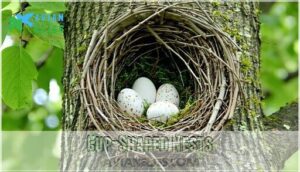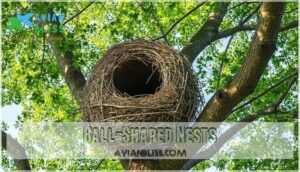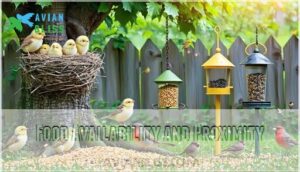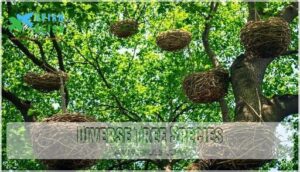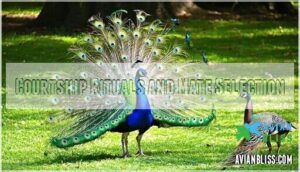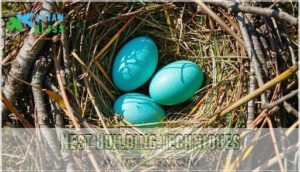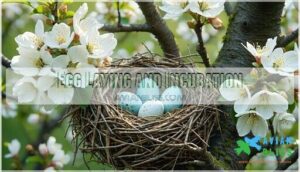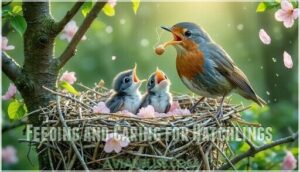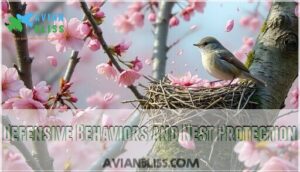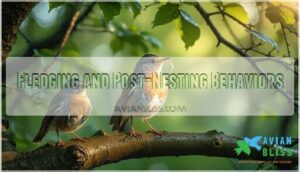This site is supported by our readers. We may earn a commission, at no cost to you, if you purchase through links.
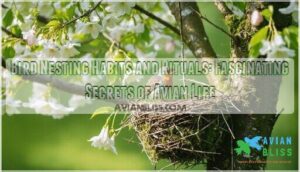
Birds carefully choose nesting sites based on food availability, safety, and camouflage.
From cup-shaped nests in trees to burrows in the ground, their designs are as diverse as the birds themselves.
Courtship rituals, like elaborate dances or sweet serenades, help secure mates, while nest building often involves weaving twigs, feathers, or even scraps of human-made materials.
Eggs are incubated with precision, keeping them warm and protected.
Once hatchlings arrive, parents work tirelessly to feed and defend them.
Curious how urban birds adapt their nesting strategies? The answers might surprise you, revealing the diverse and elaborate ways birds thrive in different environments, using their natural instincts for survival.
Table Of Contents
- Key Takeaways
- The Purpose of Nesting
- Diversity in Nesting Habits
- Nesting Site Selection
- Courtship Rituals and Mate Selection
- Nest Building Techniques
- Egg Laying and Incubation
- Challenges and Threats to Nesting
- Feeding and Caring for Hatchlings
- Defensive Behaviors and Nest Protection
- Fledging and Post-Nesting Behaviors
- Frequently Asked Questions (FAQs)
- What are bird mating rituals?
- What triggers birds to start nesting?
- Why are bird nesting habits important?
- How do birds nest?
- Why do birds make nests?
- Why is nesting important?
- Should you reach for a bird’s nest?
- What happens if you rob a bird’s nest?
- Is bird nesting good luck?
- How long will a mother bird leave her nest?
- Conclusion
Key Takeaways
- You’ll see birds select nesting spots based on safety, camouflage, and food availability, ensuring the best survival chances for their young.
- Birds build nests with precision, using diverse materials like twigs, feathers, and even human-made items for strength, insulation, and camouflage.
- Parents tirelessly incubate eggs, regulating temperature and defending their nest with clever strategies like distraction displays and alarm calls.
- From dazzling courtship dances to group defense tactics against predators, birds show remarkable cooperation and adaptability to protect and raise their young.
The Purpose of Nesting
You’ll find that birds create nests to provide a secure sanctuary where they can protect their eggs and young from predators while regulating temperature.
Birds craft nests as nature’s safe havens, shielding their eggs and young from predators while maintaining the perfect temperature.
The carefully constructed homes also serve as camouflage for vulnerable offspring, blending with surroundings to shield them from hungry eyes much like you’d use camouflage gear on a wildlife photography expedition to provide a natural form of camouflage.
Providing a Safe Environment
Birds prioritize safety above all when creating nests.
You’ll notice how they strategically select sites that offer natural predator deterrents – high branches, thorny bushes, and dense foliage serve as their security systems.
Nest camouflage is another brilliant tactic, with materials blending perfectly into surroundings.
Weather protection is equally important, as nests shield against rain, wind, and sun.
Human impact has forced many species to adapt their nest site selection, but they continue to demonstrate remarkable ingenuity in ensuring their offspring’s survival through safe materials and placement.
Regulating Egg Temperature
Once a safe nest is built, the incredible work of temperature regulation begins.
During the incubation period, parent birds maintain eggs at a precise 99-101°F through remarkable parental care behaviors.
They take incubation shifts, constantly adjusting nest insulation with their bodies.
Watch closely and you’ll notice egg turning—a essential technique ensuring even warming.
They’re natural climate engineers, controlling humidity levels too.
This delicate balance creates the perfect environment where new life can develop before hatching begins.
Camouflaging Eggs and Chicks
While eggs need proper temperature, they also require protection from hungry predators.
Nature’s best illusionists use camouflage as their secret weapon.
You’ll witness remarkable nest concealment strategies across bird species:
- Speckled egg coloration that mimics surrounding stones or bark
- Strategically placed camouflage materials like lichen or moss
- Chick down feathers in earth-toned colors that blend with nest environments
- Structural nest protection through positioning in hard-to-reach locations
This predator deterrence artwork keeps vulnerable offspring hidden in plain sight, using natural elements to conceal them.
Diversity in Nesting Habits
You’ll find that birds construct an amazing variety of nests, from cup-shaped structures woven with grass and twigs to ball-shaped homes with side entrances and simple ground scrapes lined with leaves.
Whether built in tall trees, dense bushes, or right on the ground, each nest type perfectly matches its builder’s unique survival needs and environmental challenges.
Cup-Shaped Nests
Cup-shaped nests represent one of nature’s most elegant architectural wonders you’ll encounter in the bird world.
These cozy cradles are painstakingly crafted through intricate weaving techniques that guarantee structural integrity while providing perfect nest dimensions for developing chicks.
- Material softness increases from exterior to interior, with downy linings for delicate eggs
- Nest camouflage often matches surrounding foliage, making these avian apartments nearly invisible
- Birds select materials based on flexibility and durability—spider silk adds strength without brittleness
- Construction typically takes 2-10 days, depending on species and available nesting materials
The use of downy linings and nest camouflage are crucial aspects of these nests, ensuring the safety and development of the chicks.
Ball-Shaped Nests
Many bird architects craft remarkable ball-shaped nests that resemble cozy spheres of protection.
Unlike their cup-shaped cousins, these rounded dwellings feature clever side entrances that deter predators.
Wrens and weavers excel at this nest architecture, weaving grasses, twigs, and spider silk into insulated fortresses.
You’ll notice these feathered engineers strategically position the openings underneath or laterally, creating natural defense systems.
The ball design isn’t just for show—it provides superior nest insulation against harsh weather while keeping eggs and nestlings safely tucked away in natural defense systems.
Ground-Nesting
Killdeer and plovers embrace vulnerability with their ground nests, creating shallow depressions directly on the earth.
Unlike their tree-dwelling cousins, these birds rely on camouflage strategies to protect eggs from predation.
You’ll notice their nests blend perfectly with surrounding terrain, making them nearly invisible.
Chick survival depends on this natural concealment, though habitat degradation threatens these delicate nurseries.
When hiking, watch your step—you might be inches away from a remarkable example of avian adaptation.
Nesting Site Selection
You’ll notice that birds don’t just build nests anywhere, but carefully choose locations that balance safety from predators with easy access to food sources.
Whether it’s in thorny bushes for protection, near abundant food supplies, or even in your backyard eaves, each species has developed strategic preferences that maximize their chances of successfully raising their young.
Food Availability and Proximity
Birds are master strategists when choosing nesting sites, and food availability is a top priority.
They scout for spots with nearby food sources and minimal food competition.
Here’s what they value most:
- Seasonal abundance of their preferred diet.
- Short foraging distances to conserve energy.
- Urban food options, like scraps or insects near human activity.
- Diet specialization, ensuring their chicks thrive.
It’s all about balancing convenience and survival.
Supplementing natural sources with backyard bird feeders can substantially improve nesting success.
Diverse Tree Species
Tree biodiversity plays a big role in attracting bird nests.
Different tree species cater to unique nesting preferences—oaks might host woodpeckers, while pines invite chickadees.
Canopy density and tree age also matter, offering shelter and natural materials for nest building.
A mix of trees creates a buffet of options, reducing forest fragmentation and boosting nesting sites.
Consider planting native tree species to further support local bird populations.
Think of your yard as a bird-friendly neighborhood with something for everyone!
Urban Areas With Suitable Plant Life
Urban biodiversity thrives when cities embrace green spaces for birds. Your backyard can transform into a nesting haven with thoughtful habitat restoration. Plant native species to attract feathered visitors.
Here’s how to create a bird-friendly design:
- Add shrubs and trees for shelter.
- Include flowering plants for insects and seeds.
- Avoid pesticides to protect food sources.
- Provide water features like birdbaths.
- Use humanmade materials sparingly to reduce habitat destruction.
Consider adding appropriate nesting shrubs to your yard. Simple steps, big impact on bird conservation!
Courtship Rituals and Mate Selection
Birds put on some of nature’s most enchanting shows to win a mate, using everything from intricate dances to melodic songs.
These rituals aren’t just for fun—they help females pick the strongest, most resourceful partners for raising the next generation, which is a crucial aspect of ensuring the success of the species.
Elaborate Dances and Vocalizations
Once a nest site’s chosen, the stage is set for dazzling courtship displays.
Imagine a bird talent show—pirouettes, wing flutters, and intricate mating songs fill the air.
These bird courtship rituals aren’t just for fun; they’re auditions for survival.
A male’s vocal repertoire and dance significance reveal his fitness, while females evaluate every move.
Over time, these bird mating rituals have evolved into nature’s most enchanting love performances.
For example, male kestrels perform impressive aerial acrobatics during courtship, showcasing their fitness.
Same-Sex Pairings
Courtship isn’t always predictable—same-sex pairings in birds reveal nature’s creativity.
These bonds, found in over 1,000 species, enrich social structures and often boost parenting success.
You might witness:
- Male penguins, like Sphen and Magic, raising an egg together.
- Female albatrosses forming long-term pair bond dynamics.
- Flamingo duos adopting and fiercely protecting chicks.
- Mallard drakes engaging in brief, affectionate mating rituals.
- Seagull pairs defending nests with synchronized precision.
These adoption behaviors highlight evolutionary advantages, proving parenting isn’t just about genetics.
Birds rewrite the rules, showing love and care come in all forms.
Monogamous Relationships
Birds in monogamous relationships often form lasting pair bonds, sticking together like old friends who just "get" each other.
These bonds, known as Pair Bond Duration, can last years or even a lifetime.
While Mate Fidelity is common, some species experience "divorce rates" if the partnership doesn’t work out.
Cooperative breeding strengthens these relationships, with shared parental roles like incubating eggs and feeding chicks.
Occasionally, Extra-Pair Copulation occurs, adding complexity to avian reproduction.
From aerial acrobatics to gift-giving, their courtship feels like a romantic dance-off.
Even during migration, many reunite at breeding grounds, rekindling their connection and territorial defense.
Nest Building Techniques
When birds build nests, they’re like tiny architects, using everything from twigs and grass to feathers and even bits of string.
Each species has its own style, creating structures that balance strength, comfort, and camouflage.
Using Natural Materials
In the context of nestbuilding, birds are masters of resourcefulness. They carefully select plant materials like twigs, grass, and leaves, sometimes adding animal materials like feathers or spider silk for extra durability.
Beak morphology plays a big role in their ability to weave and shape these materials. Why do they go to such lengths?
There are several reasons for this behavior, including:
- To guarantee Material Durability for harsh weather.
- To create Nest Camouflage against predators.
- To adapt to Regional Variations in available resources.
Human-Made Materials
Sometimes, birds turn urban trash into treasure.
They cleverly weave artificial materials like plastic bags, synthetic fibers, and even cigarette butts into their nests.
This urban adaptation showcases their resourcefulness but highlights a problem: plastic pollution and waste incorporation can harm chicks through entanglement or increased predator visibility.
To help, try leaving out safe nesting materials like cotton yarn or pet fur.
It’s a win-win—birds get cozy, human intervention stays positive, and the environment benefits.
Who knew human-made nests could spark such a mix of ingenuity and concern?
Nest Architecture and Design
Nature’s avian architecture is nothing short of genius. Birds adapt their nests to balance safety, comfort, and survival.
You’ll spot cup-shaped nests snugly cradling eggs, ball-shaped designs with hidden side doors, or even ground scrapes blending into their surroundings.
- Camouflage techniques like using bark or moss to hide nests.
- Structural integrity achieved with spider silk or mud for durability.
- Nest dimensions suited to species, from tiny hummingbird nests to sprawling eagle homes.
Many birds use dry grass and feathers to insulate their nests. Every nest is a masterpiece of nest complexity!
Egg Laying and Incubation
Birds carefully lay their eggs in safe, temperature-controlled nests, ensuring the best chance for survival.
During incubation, parents work tirelessly to maintain warmth, humidity, and protection, showing remarkable dedication to their future offspring, which is a key aspect of their dedication.
Clutch Size and Incubation Periods
Ever wondered why some birds lay a handful of eggs while others seem to go all out? Clutch size, or the number of eggs laid in a single batch, depends on food availability, predation risks, and habitat quality.
Smaller eggs often hatch faster, but larger ones give hatchlings a better survival shot. It’s all about balance!
Incubation periods also vary—shorter for tiny songbirds, longer for species like the Laysan Albatross. Temperature and humidity play starring roles in hatching success, with parents carefully regulating both.
American Kestrels, for example, exhibit variations in eggshell thickness regionally, influenced by environmental factors.
Here’s the breakdown:
- Egg size affects incubation temperature and parental investment.
- Environmental impact shapes clutch size and breeding success.
- Hatching success hinges on ideal incubation conditions.
Nature’s strategy? Efficiency meets survival!
Parental Roles During Incubation
Incubation isn’t a solo act—it’s teamwork at its finest.
Many bird parents master incubation shift-taking, trading off to keep the eggs warm.
Temperature regulation and egg turning keep embryos healthy, while parents also guard the nest from predators.
Some species share incubation duties equally, while others rely on one partner.
This careful balance of parental responsibilities guarantees successful egg laying, hatchling care, and eventual survival of the chicks.
Maintaining Temperature and Humidity
Keeping eggs cozy is a full-time job for parent birds.
They use their bodies like thermostats, adjusting posture to maintain incubation temperature and humidity.
Their nests, lined with insulating materials like feathers and grass, act as tiny climate-controlled shelters.
- Careful egg turning for even heat distribution
- Fluffing feathers to regulate body heat
- Nest insulation to counter weather swings
- Vigilant monitoring to guarantee temperature stability
It’s nature’s perfect incubator!
Challenges and Threats to Nesting
You’d be surprised how many challenges birds face just to keep their nests safe.
From sneaky predators to habitat loss and pollution, these threats push their survival skills to the limit, which can be considered a survival challenge.
Natural Predators
Natural predators like snakes, raccoons, and predatory birds turn nests into survival battlegrounds.
Nest predation is a constant threat, but birds are masters of disguise, using predator camouflage to blend nests into their surroundings.
Clever nest placement—high in thorny bushes or hidden in dense foliage—adds an extra layer of nest safety.
Parental defense strategies like alarm calls and distraction displays keep predators at bay.
Despite these survival skills, fledgling risks remain high as young birds take their first, precarious flights into the wild.
Human Intervention
Human activities can be both a blessing and a burden for nesting birds.
While your backyard might offer a safe haven, it can also unintentionally disrupt their fragile routines. From habitat loss to pollution impact, our actions shape their survival.
Want to help? Start small but smart.
- Dim outdoor lights to reduce light pollution; nocturnal nesters will thank you.
- Design nestboxes carefully to attract specific species, avoiding invasive ones.
- Skip pesticides—go organic to protect bird food sources from contamination.
- Lower noise levels during nesting season to avoid unsettling parents and chicks.
- Support conservation efforts by creating bird-friendly spaces in urban areas.
Remember, even humanmade nests can’t replace natural ones. Let’s turn human impact into hope for these feathered architects.
Habitat Destruction and Pollution
Regarding nesting behavior, birds face serious challenges from habitat loss and pollution.
Deforestation strips away nesting sites, while pesticide impact reduces their food supply.
Plastic ingestion and chemical runoff harm health and reproduction, turning once-thriving areas into danger zones.
Climate shifts throw off migration and nesting cycles, leaving birds scrambling to adapt.
Conservation efforts are critical to counter nesting destruction caused by habitat disturbance and pollution, ensuring these feathered architects can keep building homes.
Feeding and Caring for Hatchlings
You’d be amazed at how tirelessly bird parents work to keep their hatchlings fed and growing.
From hunting insects to regurgitating meals, they balance nutrition and care with impressive precision.
Foraging Strategies
Feeding hungry chicks is like running a never-ending buffet! Parent birds use clever foraging strategies, adapting to seasonal changes and prey availability.
Their hunting techniques are as diverse as their species. Swallows perform aerial acrobatics to snatch insects mid-flight, while robins patrol the ground for worms after rain. Kingfishers, with precision diving, pluck fish from the water in seconds.
- Prey selection: Parents prioritize protein-rich diets for rapid chick growth.
- Cooperative foraging: Some species share hunting duties to maximize efficiency.
- Food storage: Birds like shrikes impale prey for later meals.
Bird nesting habits truly showcase nature’s resourcefulness!
Food Sources
Parent birds are like chefs, crafting meals with precision based on dietary specializations. They engage in foraging strategies, snatching earthworms, caterpillars, or berries to match the seasonal abundance.
Urban food sources, like leftover crumbs, also come into play, highlighting their adaptability. Want to help? Planting native species or setting up feeders can ease food competition.
Here’s a quick look:
| Food Type | Example Prey | Nutritional Value | Seasonality |
|---|---|---|---|
| Insects | Caterpillars | High in Protein | Spring/Summer |
| Seeds | Sunflower Seeds | Energy-Rich | Year-Round |
| Berries | Elderberries | Vitamins | Fall/Winter |
| Aquatic Prey | Small Fish | Protein-Rich | Coastal Areas |
Bird feeding is nature’s buffet, ever-changing yet essential. It showcases the diversity of food sources that parent birds utilize to feed their young, making it a crucial aspect of their survival.
Parental Roles in Feeding
When it’s mealtime in the nest, bird parents are non-stop providers.
They juggle foraging frequency and diet variation to fuel their chicks’ rapid development. Feeding involves everything from regurgitation feeding—a pre-digested meal delivery system—to catching thousands of insects daily.
Here’s how they pull it off:
- Cooperative feeding: Both parents share the workload, ensuring no chick goes hungry.
- Customized diets: Meals are adjusted for chick development, from protein-packed insects to soft fruits.
- Constant care: Parental guidance extends to fledgling care, teaching young birds survival skills.
Defensive Behaviors and Nest Protection
You’ll be amazed at how fiercely birds protect their nests, using everything from loud calls to aerial acrobatics to scare off threats.
These defensive behaviors aren’t just instinct—they’re critical strategies to keep eggs and chicks safe from predators, which is a key aspect of their defensive behaviors.
Territorial Displays
Birds defending their nests are like skilled warriors guarding their turf.
Territorial displays often include puffed-up feathers, intense vocalization types, and bold aggression signals.
You’ll notice aerial dives and swoops showcasing display intensity, signaling boundary defense.
Some, like robins, use clever rituals such as pretending to be injured—a classic distraction tactic.
These defensive behaviors aren’t just for show; they’re about resource control and protecting their precious nesting spots from intruders, which is a matter of protecting their young.
Threat Responses
When danger strikes, birds switch from territorial displays to impressive threat responses, showcasing their defensive behaviors in protecting their nests.
You’ll often see:
- Distraction displays: A parent feigns injury, limping or fluttering to lure predators away from the nest.
- Alarm calls: High-pitched sounds alert nearby birds, creating a united front against intruders.
- Mobbing behavior: Groups of birds swoop and dive at predators, forcing them to retreat.
These clever predator evasion tactics highlight birds’ resourcefulness in nest defense and parental protection, even amidst nesting challenges.
Strategies to Deter Predators
In the context of predator safety, birds have some impressive strategies up their wings.
They rely on clever Camouflage Techniques, blending nests seamlessly into their surroundings—nature’s version of hide-and-seek.
Alarm Calls are another go-to tactic, alerting nearby birds to predatory species and triggering Cooperative Defense, like a feathery neighborhood watch.
Smart Nest Placement also plays a huge role, with nests tucked high in trees or hidden in thorny bushes for added nesting safety.
Some birds even use distraction, pretending to be injured to lure predators away.
It’s all about nest camouflage, threat responses, and ensuring their chicks stay safe.
Fledging and Post-Nesting Behaviors
When young birds leave the nest, it’s a mix of wobbly first flights and cautious exploration as they learn to navigate the world.
You’ll notice parents still keeping a watchful eye, guiding their fledglings until they’re ready to be fully independent.
Leaving The Nest
When the moment of fledging arrives, it’s like baby birds taking their first steps—only in the air.
Fledgling independence begins as they flutter and hop, awkward but determined.
Parents stick close, offering guidance and protection while teaching survival skills.
This phase of bird development is critical, as nest abandonment exposes them to predators.
Still, it’s nature’s way of preparing them for life’s challenges and eventual migration preparation.
Migration Patterns
Once young birds leave the nest, their migration patterns are nothing short of extraordinary.
They rely on sharp navigation skills, like reading stars, the sun, and Earth’s magnetic field. Seasonal movements are triggered by food availability and weather shifts, but challenges abound.
Climate impacts are reshaping routes, adding new hurdles. Along the way, stopover sites offer rest and refueling. Birds utilize visual landmarks to aid in navigation.
Here’s how bird migration unfolds:
- Migration Triggers: Seasonal changes prompt journeys.
- Navigation Skills: Birds use natural compasses.
- Stopover Sites: Critical for survival.
- Climate Impacts: Altering traditional paths.
Nesting Cycles
Nesting cycles are a wonder to observe, blending nature’s rhythm and bird behavior.
Seasonal breeding guarantees food abundance when fledglings learn to fly. Some birds embrace nest reuse, sprucing old nests, while others show fresh beginnings. Renesting attempts follow nest abandonment, a survival tactic.
The cycle is an ongoing dance of life.
Here’s a quick snapshot of nesting habits:
| Behavior | Details |
|---|---|
| Seasonal Breeding | Timed with resource abundance |
| Nest Reuse | Adds efficiency to nesting rituals |
| Renesting Attempts | A second chance after challenges arise |
Pay attention—you just might experience this miracle in your backyard!
Frequently Asked Questions (FAQs)
What are bird mating rituals?
Birds woo mates with stunning dances, vibrant plumage, and melodic songs.
Males often strut their stuff, offering food or building nests to impress.
It’s nature’s version of speed dating, but with feathers and flair!
What triggers birds to start nesting?
Changing daylight hours, warmer temperatures, and food availability signal birds to start nesting.
It’s like nature’s alarm clock, telling them it’s time to find a safe spot, gather materials, and prepare for chicks.
Why are bird nesting habits important?
Understanding nesting habits helps you see how birds protect their young, adapt to challenges, and thrive in different environments.
It also highlights their role in ecosystems, balancing predators, spreading seeds, and enriching biodiversity.
Understanding how birds thrive in different environments is crucial for their survival.
How do birds nest?
You’d be amazed how birds build nests—using twigs, grass, feathers, even scraps of plastic.
With precise beak work, they weave cozy shelters in trees, bushes, or cliffs, balancing safety, food access, and camouflage perfectly.
Why do birds make nests?
It’s like nature’s blueprint for survival—nests aren’t just homes, they’re protective cradles.
Birds build them to shelter eggs, guard against predators, and create a cozy spot for raising their young in safety and warmth.
Why is nesting important?
Nesting’s essential for birds—it’s their home base for laying eggs, incubating, and raising chicks.
It offers protection from predators and the elements, ensuring survival.
Think of it as nature’s cozy, life-sustaining nursery!
Should you reach for a bird’s nest?
Think twice before reaching for a bird’s nest—interrupting it’s like barging into someone’s home uninvited.
It’s stressful for the birds and can harm their eggs or chicks.
Observe respectfully from a safe distance.
What happens if you rob a bird’s nest?
If you rob a bird’s nest, you disrupt their breeding cycle, stressing the parents and endangering eggs or chicks.
This can harm bird populations and is illegal in many places.
Let nature thrive undisturbed.
Is bird nesting good luck?
Some believe finding a bird nest brings good luck, symbolizing new beginnings and harmony.
While luck’s debatable, it’s always a treat to witness nature’s artistry up close!
Scientifically, it reflects a healthy environment.
How long will a mother bird leave her nest?
A mother bird’s absence from the nest is short, typically just minutes.
Like a quick coffee run for sustenance, she leaves to eat, drink, or distract predators, ensuring her eggs stay warm and safe.
Conclusion
It’s almost magical how bird nesting habits and rituals weave together survival with astonishing ingenuity.
You’ve seen how birds cleverly design nests, select mates through charming rituals, and protect their young with fierce determination.
From urban rooftops to dense forests, their adaptability is inspiring.
As you observe birds in your area, notice their intricate nesting efforts—they’re nature’s engineers, balancing beauty and practicality.
Truly, understanding bird nesting habits opens a window into the extraordinary rhythms of avian life, and reveals the astonishing ingenuity of these creatures.


